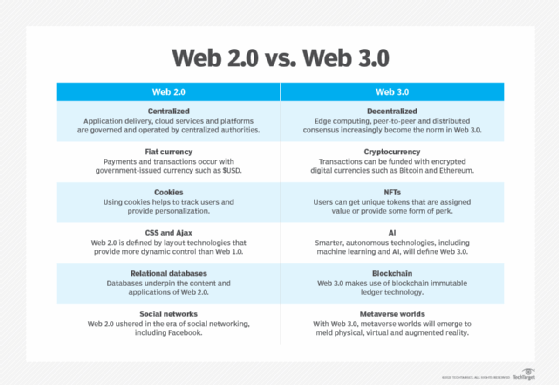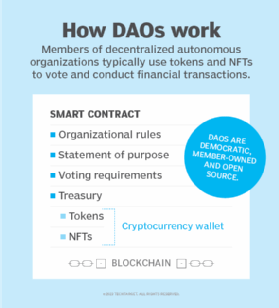10 core features of Web 3.0 technology
Web 3.0 promises to provide what Web 2.0 can't: autonomy for content creators to monetize their own data through blockchain, decentralization, user data ownership and private keys.
Web 3.0 is a work in progress. The coming new iteration of the World Wide Web will be decentralized, with distributed control to provide greater autonomy for content creators.
Meanwhile, Web 2.0, the current generation of the internet, won't go away any time soon. The transition will likely take place over the next 18 to 24 months. Exact contours of Web 3.0 are in flux, but proponents expect it to have these 10 core features.
1. Decentralization of data and protocols
Web 2.0 uses centralized services, servers and software, according to Avivah Litan, vice president and distinguished analyst at Gartner. It requires content creators to trust large companies like Meta to treat their data and intellectual property with respect and allow the tech giants to monetize that data. Many people believe those companies have had too much power. By contrast, Web 3.0 is decentralized and peer-to-peer, with no central authority and no single point of failure, enabling content creators to monetize their own data, to which they have a private key.
2. Decentralized governance
Decentralization is among the more important concepts of Web 3.0. Power is not concentrated with central corporate authorities, but instead is held by decentralized autonomous organizations, where it's distributed to stakeholders, Litan explained. Anyone holding a governance token will receive the right to vote on propositions and participate in decisions concerning protocols.
This article is part of
What is Web 3.0 (Web3)? Definition, guide and history
3. Redefined data ownership
In the Web 2.0 world, large digital enterprises and service providers own customer data, which they mine to earn revenue, Litan said. Consumers willingly swap their personal data for the right to use a platform such as Facebook. For Web 3.0, content is decoupled from Web 2.0 services. Users would own their own data and monetize it, with payments made directly to blockchain transaction validators.

4. Trustless and permission-less controls and environments
Web 3.0 purports to be a "trustless" environment in which the decentralized data network protocol has built-in protections. Blockchain, for example, is considered trust- and permission-free because no single third party oversees ownership. It's worth noting that "trustless" doesn't mean fully automated. Blockchain technology requires people to validate transactions that are stored in a public ledger for all to see.
5. Use of blockchain and smart contract technologies
Web 3.0 emerged from the advent of cryptocurrency and blockchain, according to Tom Taulli, Web 3.0 expert and author of How to Create a Web3 Startup: A Guide for Tomorrow's Breakout Companies. These developments enabled fungible tokens -- aka cryptocurrency -- to be programmed via smart contracts on top of blockchain that execute automatically when a certain condition is met, such as releasing of funds. The blockchain is then updated when the condition is met to reflect new ownership. There's no centralized control, such as a financial institution, and no intermediaries to pay.
6. Utilization of private keys for user authentication
Web 2.0 relies on user IDs, passwords and biometric means of authentication like Face ID. Web 3.0 users, Litan said, will hold private keys that unlock access to their records on a blockchain. The private key may reside in a ledger, self-hosted wallet or third-party wallet like ZenGo.

7. Advanced AI algorithms
Artificial intelligence, machine learning and natural language processing are not inherently Web 3.0 and are currently used on Web 2.0, but they will be important to Web 3.0 by enabling immersive user experiences. In addition to gaming and consumer applications, immersive experiences might be used by enterprises in areas like training, supply chain monitoring and predictive asset maintenance.
8. Ubiquitous IoT, edge connectivity
Web 3.0 proponents say the Semantic Web will be ubiquitous, thanks to edge connectivity. Edge computing is a foundational technology for Web 3.0 and will enable support for data-heavy immersive experiences that include video, AI, augmented reality (AR) and virtual reality (VR). Edge computing involves moving computing and storage functions closer to data sources at the edge of the network, decreasing the distance that data needs to travel and enabling faster processing with low latency.
9. Metaverse support
The metaverse and Web 3.0 are not the same, but they do intersect. "The metaverse is the convergence of simulated and augmented worlds," said Scott Likens, innovation hub and trust technology leader at PwC. Metaverse-like experiences can operate on Web 2.0, yet Web 3.0 should make it easier to create and use virtual worlds -- for example, a simulated environment in which medical students learn how to perform surgery in a lower-risk setting.
10. 3D virtual reality spaces with lifelike spatial UX
Metaverse-like experiences operating on Web 2.0 are flat and two-dimensional, Likens noted. The metaverse will be three-dimensional on Web 3.0. "We will see the merging of VR, AR and XR [extended reality] technology," Likens speculated. "This will be a great opportunity for companies to engage their workforce in a much richer way. And employees want that."








